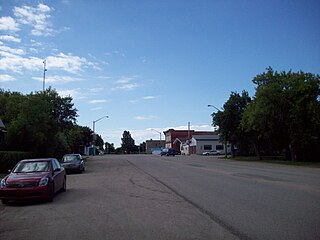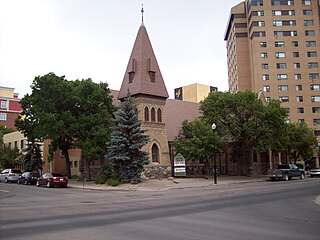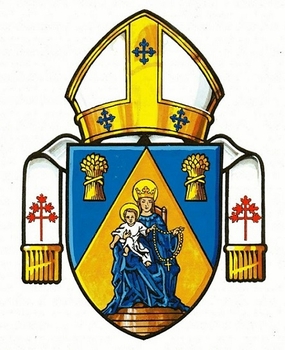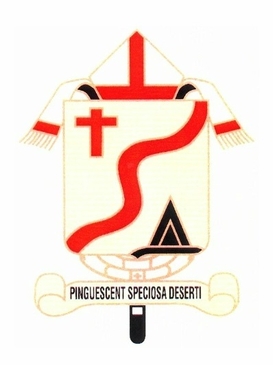A co-cathedral is a cathedral church which shares the function of being a bishop's seat, or cathedra, with another cathedral, often in another city. Instances of this occurred in England before the Protestant Reformation in the dioceses of 'Bath and Wells', and of 'Coventry and Lichfield'. These two dioceses were each named for both cities that served as bishop's seats.

Fransaskois, , Franco-Saskatchewanais or Franco-Saskatchewanians are French Canadians or Canadian francophones living in the province of Saskatchewan. According to the 2016 Canadian Census, approximately 17,735 residents of the province stated that French was their mother tongue. In the same census, 125,810 Saskatchewanians claimed full or partial French ancestry. There are several Fransaskois communities in Saskatchewan, although the majority of francophones in Saskatchewan reside in the province's three largest cities, Saskatoon, Regina, and Prince Albert.

Gravelbourg is a small multicultural town in south-central Saskatchewan, Canada. It is located just west of the Wood River at the junction of provincial Highway 43 and Highway 58, approximately 125 kilometres from Moose Jaw, Swift Current, and the United States border. The region served as a path for First Nations peoples many years ago, and was also integrated into the Redcoat Trail of the 19th century. Gravelbourg is now a key link on the 21st century Trans Canada Trail.

The Basilica-Cathedral of St. John the Baptist in St. John's, Newfoundland and Labrador is the metropolitan cathedral of the Roman Catholic Archdiocese of St. John's, Newfoundland and the mother church and symbol of Roman Catholicism in Newfoundland. The building sits within the St. John's Ecclesiastical District, a National Historic District of Canada.

Qu'Appelle is a town in Saskatchewan, located on Highway 35 approximately 50 kilometres (31 mi) east of the provincial capital of Regina.

St Paul's Anglican Cathedral is an historic church building located on the outskirts of Regina's central business district. Built as a parish church in 1894–1895, it became the pro-cathedral of the Anglican Diocese of Qu'Appelle in southern Saskatchewan, Canada, in 1944 when pro-cathedral status was removed from St Peter's, Qu'Appelle, in the eponymous former see city which had become moribund. In 1973, when it had become clear that the once-planned grand cathedral for Regina — at the corner of Broad Street and College Avenue — was no longer a feasible project, its status was raised to that of cathedral.

Holy Rosary Cathedral at 13th Avenue and Garnet Street in Regina, Saskatchewan, Canada, is the cathedral church of the Roman Catholic Archdiocese of Regina.

The Diocese of Qu'Appelle in the Anglican Church of Canada lies in the southern third of the civil province of Saskatchewan and contains within its geographical boundaries some 50 per cent of the province's population of one million.

Our Lady of Assumption Co-Cathedral or the Co-Cathédrale de Notre-Dame-de-l’Assomption is located in the Canadian prairie town of Gravelbourg, Saskatchewan.

Many historically significant buildings in Regina, Saskatchewan were lost during the period 1945 through approximately 1970 when the urge to "modernize" overtook developers' and city planners' sense of history and heritage. The old warehouse district to the north of the old CPR tracks was Regina's original commercial raison d'être once Lieutenant-Governor Edgar Dewdney had established the site of his considerable landholdings as the Territorial Capital. 1899 to 1919 Washington Park and 3431 Dewdney Ave building as CPR commercial logistics building, expanded connected with significant conversion of shipping of commercial goods from train to truck and cancellation of passenger service on the railway, the Warehouse District immediately adjacent to the train line has ceased to be exclusively industrial in character. Some areas of the Warehouse District have been transformed into a shopping, entertainment and residential precinct.

The Roman Catholic Archdiocese of Regina is a Roman Catholic archdiocese comprising the southern part of the Canadian province of Saskatchewan, as far north as the 30th township, or about 51°30' lat. The metropolitan province includes the suffragan dioceses of Prince Albert and Saskatoon. The seat of the diocese is in the city of Regina.

The Roman Catholic Archdiocese of Saint-Boniface is a Latin archdiocese in part of the civil Province of Manitoba in Canada. Despite having no suffragan dioceses, the archdiocese is nominally metropolitan and is an ecclesiastical province by itself. It is currently led by Archbishop Albert LeGatt.
The Diocese of Prince-Albert, in Saskatchewan, is a Latin Catholic suffragan in the western Canadian ecclesiastical province of the Metropolitan Archdiocese of Regina.

The Diocese of Bathurst is a Roman Catholic suffragan of the Archdiocese of Moncton. It has its cathedral episcopal see, Sacred Heart Cathedral, in Bathurst, New Brunswick, Canada.

Seven neighbourhoods are of considerable note:
Louis-Pierre Gravel was a French Canadian missionary and colonizer who founded the town of Gravelbourg in Saskatchewan, Canada. He was born in Stanfold, Quebec on August 8, 1868, and was ordained as priest on August 28, 1892, after finishing his studies at seminaries in Trois-Rivières, Nicolet and Montreal, Quebec. After serving in parishes in New York City from 1892 to 1906, he was asked to found a French Canadian parish in the south-west of Saskatchewan. In 1906, he founded the town of Gravelbourg. Aiding him in his endeavors were five of his brothers, which included Henri and Maurice, both doctors; Alphonse and Emile, both lawyer; Guy, a pharmacist; plus a sister, Laurianne, the wife of Georges Hébert, also a lawyer. He persuaded many French Canadian Catholics to settle in the Gravelbourg, Lafleche, Mazenod, Meyronne bloc settlement. Father Gravel died in Montreal on February 10, 1926, and was buried in Gravelbourg.

Saints Mary and Joseph Catholic Cathedral is a heritage-listed cathedral at 132 Dangar Street, Armidale, Armidale Regional Council, New South Wales, Australia. It is the diocesan cathedral of the Roman Catholic Diocese of Armidale and the seat of the Catholic Bishop of Armidale. The cathedral was designed by John Hennessy of Sheerin and Hennessy, and built from 1911 to 1912 by George Frederick Nott. It is also known as the St Mary & St Joseph Catholic Cathedral and the Cathedral of Saint Mary and Saint Joseph. It was added to the New South Wales State Heritage Register on 13 February 2015.

Cathedral of St Michael and St John is a heritage-listed Roman Catholic cathedral at 107 William Street, Bathurst, Bathurst Region, New South Wales, Australia. It was designed by Charles Hansom and built from 1857 to 1861 by Edward Gell. It is also known as Cathedral of Saints Michael and John. The cathedral is the episcopal see of the Roman Catholic Bishop of Bathurst. The property is owned by the Roman Catholic Diocese of Bathurst. It was added to the New South Wales State Heritage Register on 5 June 2012.

St Peter and Paul's Old Cathedral is a heritage-listed former Catholic cathedral and now parish church at 42 Verner Street, Goulburn, Goulburn Mulwaree Council, New South Wales, Australia. It was designed by Andrea Stombuco and Charles Spadacini and built from 1871 to 1890 by C. J. O'Brien and Wilkie Bros. It is also known as St. Peter and Paul's Former Cathedral and St Peter and Paul's Catholic Cathedral; Saints Peter and Paul's Catholic Cathedral. It was added to the New South Wales State Heritage Register on 20 April 2009.

















